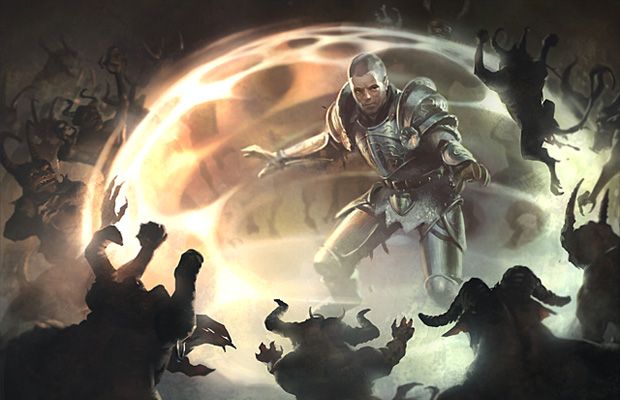
Art by D. Alexander Gregory
The gates are open, and all ten guilds of Ravnica are available to players old and new in Magic: the Gathering’s Standard format. This is one of the problems with the format, actually: every few months, the available cards change radically. Some previously robust deck solutions get the wind taken out of their sails, while previously unrealized options come to light. But in this rotation, something I didn’t quite expect has happened. The field has opened up to allow some old favorites from a previous rotation to become viable.
Last block, a card was introduced that I absolutely adore. It’s not a planeswalker, a majorly powerful instant kill sorcery, or a creature with massive stats and fantastic keywords. No, my favorite card of the Innistrad block is the humble [mtg_card]Lingering Souls[/mtg_card]. It keeps emerging in my decks – Vengeance at Dawn back when Scars of Mirrodin was part of Standard, Spirit Squadron when that rotated out, a token deck in Modern – and there’s good reason for that. It only costs three mana to cast, and having two flying creatures on the field at turn three is a powerful field position even if they’re small. In addition, it has a flashback cost, meaning it can be cast again after its first use. And in an inversion of the usual setup of such spells, the flashback cost is lower than the regular cost. This means that in subsequent turns, the spell is even easier to cast, provided it’s not removed from your graveyard.
One thing I’ve discovered is that creatures cannot always be relied upon to secure a win. There are all sorts of ways to avoid dying to creature damage: big blockers, sweepers, gaining life, and so on. Some players find ways around this with direct damage, creatures resilient to being destroyed or capable of evading defenders, or some combination of spells to pull the rug out from under your opponent, such as in OMNIDOOR THRAGFIRE! and older decks that use dreaded “infinite combos”. Like many tools in a competitive game, such combos are the sort of thing that feel blatantly unfair when you’re on the recieving end of their shenanigans, but when you pull apart the mechanics, you can see the ingenuity involved and realize why some players may choose that route. Remember, neither I nor any other person has the right to tell other people how to play their games.
Standard now does feature one of these combinations. Gatecrash introduced us to the [mtg_card]Vizkopa Guildmage[/mtg_card]. Her second ability states that whenever you gain life, each opponent loses that much life. This is useful when you include the new Extort keyword, but the last block’s final expansion, Avacyn Restored, gave us the enchantment [mtg_card]Exquisite Blood[/mtg_card]. “Whenever an opponent loses life, you gain that much life.” With both cards in play, and the Guildmage’s ability active, all one has to do is gain one life, or deal one damage or steal one point for your opponent, and a positive feedback loop begins.
This combo is not foolproof. While it’s powered by an enchantment, which are very difficult to get rid of, the other major component is a creature. They’re vulnerable, and if she hits the battlefield too soon, every turn is another turn that could see her getting blasted. Thus the ideal situation is to summon her, activate her ability, and set off the loop all on the same turn. This requires mana. Thankfully, there are ways to generate all of that energy even without green. The new creature [mtg_card]Crypt Ghast[/mtg_card] causes more black to come our Swamps, while alluring but deadly planeswalker [mtg_card]Liliana of the Dark Realms[/mtg_card] gets more of those Swamps for us to use.
[mtg_deck title=”Walking After Midnight”]
// Creatures
4 Crypt Ghast
3 Vizkopa Guildmage
// Sorceries
4 Lingering Souls
// Instants
4 Tragic Slip
3 Beckon Apparition
// Planeswalkers
2 Liliana of the Dark Realms
2 Sorin, Lord of Innistrad
// Enchantments
4 Intangible Virtue
4 Blind Obedience
3 Oblivion Ring
2 Exquisite Blood
// Lands
4 Godless Shrine
4 Isolated Chapel
8 Swamp
7 Plains
2 Vault of the Archangel
// Sideboard
3 Sundering Growth
3 Ultimate Price
3 Nevermore
2 Rest in Peace
2 Chalice of Life
2 Midnight Haunting
[/mtg_deck]
The idea in Walking After Midnight is to have more than one win condition. One is our combo, and the other is an overwhelming force of tokens. The old, tried-and-true setup of Lingering Souls, [mtg_card]Intangible Virtue[/mtg_card], and [mtg_card]Sorin, Lord of Innistrad[/mtg_card] is the fuel for that potential army. To get either of these things going properly, we’ll need mana (as mentioned before) and time. We get time by using the final portion of the deck: control. We exert control over aggressive creatures with [mtg_card]Tragic Slip[/mtg_card] and [mtg_card]Blind Obedience[/mtg_card], eliminate creatures or other permanent threats with [mtg_card]Oblivion Ring[/mtg_card], and [mtg_card]Beckon Apparition[/mtg_card] removes potential targets for reanimation or flashback. And the deck also uses the aforementioned Extort mechanic to equalize when necessary as well as setting off the combo win condition. The sideboard deals with more specific threats, and packs a way to set off our combo if the opponent has a way to resist damage or loss of life.
It’s not perfect, but it’s resilient to sweeping spells, accelerates quickly, and if nothing else, should be fun to spring on people who don’t expect it.
How does the deck look to you? What would you change? How would you shut it down?






